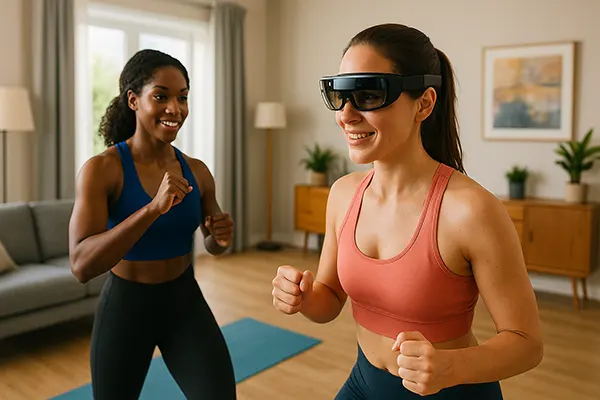
Virtual Fitness Instructors: The Future of Training in Augmented Reality
As of February 2025, virtual fitness instructors powered by augmented reality are no longer futuristic concepts—they are practical tools reshaping the way people train. This technology offers personalised, real-time support for workouts at home, in gyms, or outdoors, bridging the gap between physical presence and digital precision. With AR devices becoming more affordable and intelligent, these virtual guides are revolutionising personal training for a wide range of users, from beginners to seasoned athletes.
The Rise of AR in the Fitness Industry
The integration of augmented reality into the fitness sector has seen a rapid rise in recent years. Leading developers now offer systems that blend physical movements with digital overlays, guiding users through complex exercises with real-time corrections. Unlike traditional training videos or apps, these systems are responsive—they see how you move and adjust accordingly.
Tech companies such as Meta, Apple, and Magic Leap have been investing in wearables and AR interfaces that turn living rooms into interactive gyms. Smart glasses or AR-enabled devices display virtual instructors who guide users through customised routines, making fitness more engaging and efficient. The trend reflects broader shifts in how consumers seek flexibility and convenience without compromising the quality of their workouts.
This evolution also aligns with the demand for data-driven training. Many AR fitness tools collect biometric data, track progress, and adjust exercise intensity to match individual goals. This adaptability makes them a viable alternative to in-person coaching, especially for users who want affordable and scalable solutions.
Benefits for Everyday Users
Virtual instructors in AR environments offer clear advantages: cost-effective training, tailored workouts, and the ability to exercise anywhere. These tools are ideal for people with limited time or access to gyms, as well as for those who prefer private sessions at home.
Another major benefit is injury prevention. Real-time posture and movement correction reduces the risk of strain or overuse injuries, especially in strength training or high-intensity routines. This level of feedback is rarely available without a physical trainer present.
Furthermore, these systems often include gamified elements—rewards, challenges, and virtual achievements—that enhance motivation and maintain user engagement over the long term. This gamification approach can help break down psychological barriers to consistent exercise.
Technology Behind the Experience
Augmented reality fitness instructors operate through a combination of hardware, software, and artificial intelligence. The core setup usually includes AR glasses or headsets, motion sensors, and apps that connect to cloud-based platforms for real-time data processing and feedback.
AI-driven algorithms interpret body movements using skeletal tracking, which allows the system to understand form, pace, and coordination. This data is used to assess performance and deliver immediate cues such as “lift higher” or “straighten your back” through voice or visual prompts from the virtual coach.
While early versions were limited in function, current-generation tools leverage advanced machine learning models that adapt to the user’s progress and history. This means routines get smarter the more you train, providing an evolving experience that keeps workouts both safe and effective.
Current Limitations and Challenges
Despite its potential, AR-based training is not without challenges. The initial cost of equipment like smart glasses or motion sensors can be a barrier for some users, although prices are expected to fall as technology matures.
Another issue is space. Many systems require a clear area for motion tracking, which may not be feasible in small homes or flats. Lighting and room layout can also impact sensor accuracy and user experience.
Privacy and data handling are also major concerns. These systems often collect sensitive health and movement data, requiring transparent privacy policies and strong security protocols to build user trust. Addressing these concerns is essential for wider adoption.

Future Outlook and Market Trends
Looking ahead, the role of virtual fitness instructors is likely to expand across new markets and demographics. Schools, rehabilitation centres, and corporate wellness programmes are beginning to explore AR training for education, therapy, and staff wellbeing initiatives.
Integration with other wearables—such as smartwatches, heart rate monitors, and muscle sensors—will enhance the capabilities of virtual instructors, offering a more comprehensive view of user health and performance. These connected systems could eventually allow for complete biometric coaching.
Industry forecasts suggest steady growth in AR fitness solutions, especially as 5G and edge computing improve the responsiveness of cloud-based systems. By 2030, virtual instructors may become as commonplace as yoga mats or dumbbells in households around the world.
What Users Can Expect Next
In the near future, users can expect more accessible and intuitive systems, thanks to ongoing advances in hardware and AI. Gesture control, voice activation, and improved battery life will all contribute to smoother and more immersive training sessions.
Multilingual support and cultural adaptation will make these tools usable by diverse populations, allowing for truly global uptake. Localised fitness content, combined with universal design principles, will broaden appeal beyond early tech adopters.
Ultimately, virtual fitness instructors in augmented reality will continue to evolve from novelty tools into trusted companions on the path to better health. As the technology matures, the gap between digital coaching and in-person guidance will shrink further—empowering more people to take control of their fitness journey on their own terms.
